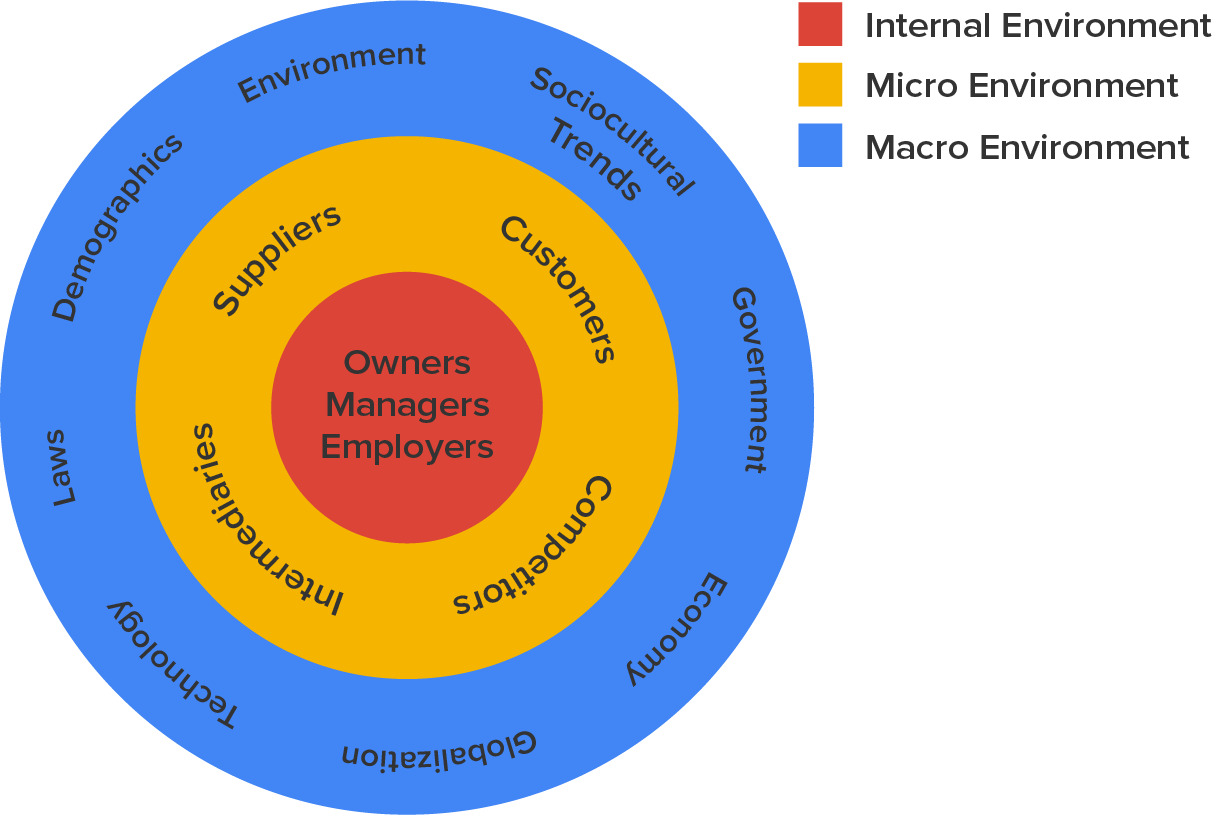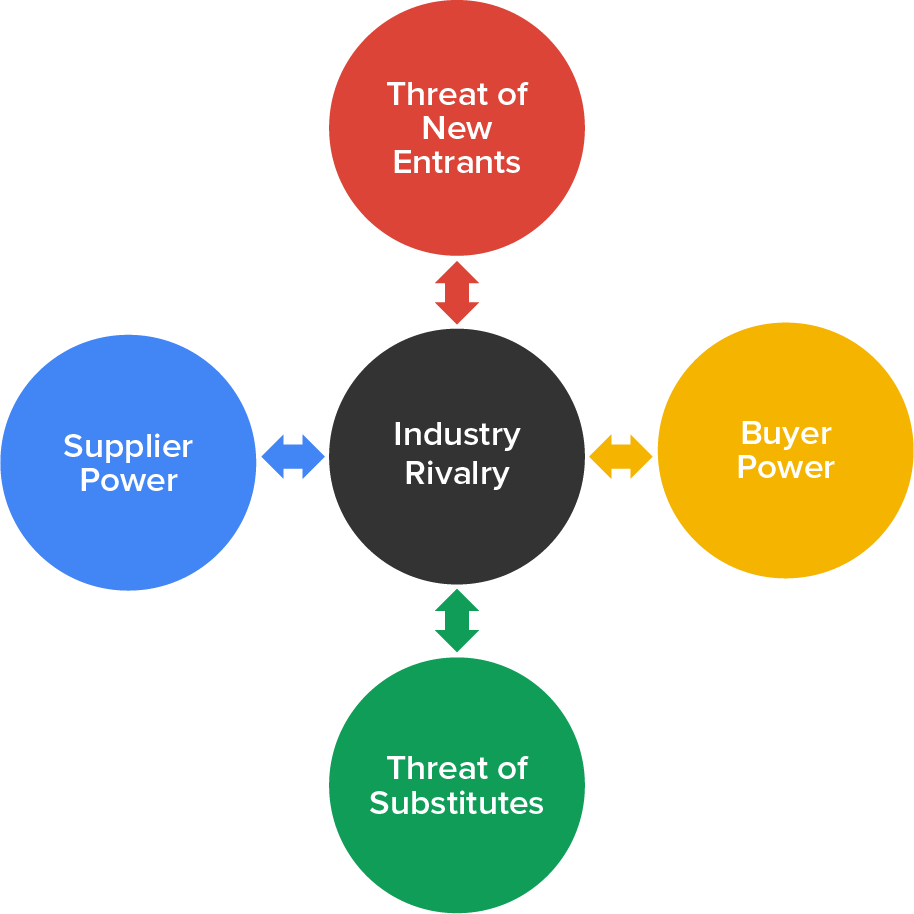Table of Contents |
A firm’s micro environment is illustrated in the diagram below. These entities are all directly connected to the firm in some way, and firms must understand the micro environment in order to successfully compete in an industry. All firms are part of an industry—a group of firms all making similar products or offering similar services; for example, automobile manufacturers or airlines. Virtually all firms have suppliers who sell parts, materials, labor, or products. Supplier power refers to the balance of power in the relationship between firms and their suppliers in an industry. Increasing the number of suppliers so they are competing with one another for your business can often reduce costs. The more suppliers that can supply the same or similar parts, the more options you have as a buyer, and the competition between suppliers can lead to investment, improvements, and better parts. Conversely, if only one supplier is available, they may lack the motivational competition to justify investment costs or improvements, leading to no changes, or impact your own competitivity. Firms in an industry may or may not compete directly against one another, as we’ll discuss shortly, but they all face similar situations in terms of customer interests, supplier relations, and industry growth or decline.

Harvard strategy professor Michael Porter developed a framework to evaluate a firm’s micro environment. Porter’s Five Forces is a tool used to examine different micro-environmental factors in order to understand the impact each has on a firm in an industry. Each of the forces represents an aspect of competition that affects a firm’s potential to be successful in its industry. It is important to note that this tool is different than Porter’s generic strategy typology that we will discuss later.

Industry rivalry, the first of Porter’s forces, is in the center of the diagram. Note that the arrows in the diagram show two-way relationships between rivalry and all of the other forces. This is because each force can affect how hard firms in an industry must compete against each other to gain customers, establish favorable supplier relationships, and defend themselves against new firms entering the industry. Part of that rivalry involves competition for skilled labor and employees. As growth occurs, rivalries will tend to increase competition for employees, raising compensation. From the employee perspective, you can learn more about your industry to assess growth and opportunities to move up the ladder of success across businesses and companies.
When using Porter’s model, an analyst will determine if each force has a strong or weak impact on industry firms. In the case of rivalry, the question of strength focuses on how hard firms must fight against industry rivals (competitors) to gain customers and market share. Strong rivalry in an industry reduces the profit potential for all firms because consumers have many firms from which to purchase products or services.
In an industry, there are incumbent (existing) firms that compete against each other as rivals. If an industry has a growing market or is very profitable, however, it may attract new entrants. These either are firms that start up in the industry as new companies or are firms from another industry that expand their capabilities or target markets to compete in an industry that is new to them. Different industries may be easier or harder to enter depending on barriers to entry—factors that prevent new firms from successfully competing in the industry. Common barriers to entry include cost, brand loyalty, and industry growth.
EXAMPLE
The firms in the airline industry rarely face threats from new entrants because it is very expensive to obtain the equipment, airport landing rights, and expertise to start up a new airline.Brand loyalty can also keep new firms from entering an industry, because customers who are familiar with a strong brand name may be unwilling to try a new, unknown brand. Further, industry growth may increase or decrease the chances a new entrant will succeed.
In the context of Porter’s model, a substitute is any other product or service that can satisfy the same need for a customer as an industry’s offerings. Be careful not to confuse substitutes with rivals. Rivals offer similar products or services and directly compete with one another. Substitutes are completely different products or services that consumers would be willing to use instead of the product they currently use. Margarine and butter are examples of product substitutes.
Virtually all firms have suppliers who sell parts, materials, labor, or products. Supplier power refers to the balance of power in the relationship between firms and their suppliers in an industry. Suppliers can have the upper hand in a relationship if they offer specialized products or control rare resources.
EXAMPLE
When Sony develops a new PlayStation model, it often works with a single supplier to develop the most advanced processor chip it can for their game console. That means its supplier will be able to command a fairly high price for the processors, an indication that the supplier has power. On the other hand, a firm that needs commodity resources such as oil, wheat, or aluminum in its operations will have many suppliers to choose from and can easily switch suppliers if price or quality is better from a new partner.The last of Porter’s forces is buyer power, which refers to the balance of power in the relationship between a firm and its customers. If a firm provides a unique good or service, it will have the power to charge its customers premium prices, because those customers have no choice but to buy from the firm if they need that product. In contrast, when customers have many potential sources for a product, firms will need to attract customers by offering better prices or better value for the money if they want to sell their products.
One protection firms have against buyer power is switching costs, the penalty consumers face when they choose to use a particular product made by a different company. Switching costs can be financial (the extra price paid to choose a different product) or practical (the time or hassle required to switch to a different product).
Source: THIS TUTORIAL HAS BEEN ADAPTED FROM OPENSTAX “PRINCIPLES OF MANAGEMENT”. ACCESS FOR FREE AT OPEN STAX. LICENSE: CREATIVE COMMONS ATTRIBUTION 4.0 INTERNATIONAL.